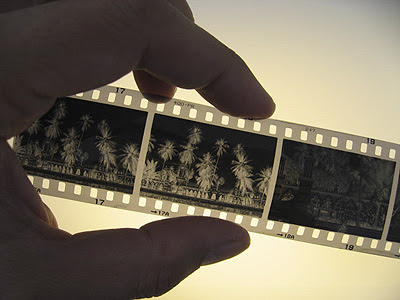
Film strips! They were once everywhere, handled ever so gently in case they gotten scratched or worse; held up to the light with straining necks and loupes; and filed away in anti-static polythene sleeves. I have files and files of these damn things, of images taken over the years. Luckily, common sense prevailed early on and I filed them logically according by date and place. So searching for images should be a doddle. Last couple of days I began scanning 20 or so images of which I am preparing to print for an exhibition in the fall. These photos are from my KL book so searching for them was relatively easy as they were taken over a period from 1998 to 2000. This was also a test of my filing system. Suffice to say, I found all 20 frames with little strain and effort. Yes! My filing system works.
The next task was to scan them to the required resolution and size. This was fun to start with, going through old negs was a trip down memory lane. What interested me wasn't the selected frames, but those that were 'rejects', the pre- and post-frames of the chosen ones that did not see the light of day and hence did not graduate into prints.
Examining the sequencing of images, on negatives or contact sheets is invaluable to a photographers' thought process. This I learned at a photojournalism course back in 2001 at Speos college in Paris and is something I still practice when editing. We were given daily tasks and to shoot 3 or 4 rolls of film to tell a story. Each day, we processed and contact-sheeted the films for analysis by another participant. It was very interesting to understand how each person 'saw' and photographed his or her story, how the final frame was chosen by the course director and reasoning behind his choice.
I did say this was fun to begin, but once the negs are scanned, then I would envisage hours spent on the computer 'processing' the images. 'Spotting' is still done, not with a thin brush and Spotone, but with clicks on a mouse..colour balancing, sharpening etc. These processes still take skill and time. The digital lightroom however is a more pleasant process, has no smelly chemicals and light-sensitive paper, cluttered bathroom, etc.. and I can do it in daylight whilst listening to the radio or watching TV!
The last roll of film I shot was 2 summers ago, and its still in the camera!
The next task was to scan them to the required resolution and size. This was fun to start with, going through old negs was a trip down memory lane. What interested me wasn't the selected frames, but those that were 'rejects', the pre- and post-frames of the chosen ones that did not see the light of day and hence did not graduate into prints.
Examining the sequencing of images, on negatives or contact sheets is invaluable to a photographers' thought process. This I learned at a photojournalism course back in 2001 at Speos college in Paris and is something I still practice when editing. We were given daily tasks and to shoot 3 or 4 rolls of film to tell a story. Each day, we processed and contact-sheeted the films for analysis by another participant. It was very interesting to understand how each person 'saw' and photographed his or her story, how the final frame was chosen by the course director and reasoning behind his choice.
I did say this was fun to begin, but once the negs are scanned, then I would envisage hours spent on the computer 'processing' the images. 'Spotting' is still done, not with a thin brush and Spotone, but with clicks on a mouse..colour balancing, sharpening etc. These processes still take skill and time. The digital lightroom however is a more pleasant process, has no smelly chemicals and light-sensitive paper, cluttered bathroom, etc.. and I can do it in daylight whilst listening to the radio or watching TV!
The last roll of film I shot was 2 summers ago, and its still in the camera!


4 comments:
hey steven! good to see your blog. i heard from zorro that you started one but i never got to get your url from him. thanks for dropping by. i am going to have you on my blogroll.
my regards to lis. she won't blog?
Hi Rocky, thanks for visiting and what are you doing up at 4am? I may yet convince her to start a blog! I am only on my first week, to find my way around before announcing it, maybe you can do that for me! Wink! Wink!
Hi, I love the pics in your blog.
B & W is still the best. I still have my parents' B&W photos all nice and clear though most of them are more than half century old! :-)
Steven, agree with helen...nothing like black/white...they dont fade so easily depending if it is in an album. Rocky at 4am....the guy sleeps after 4am, dont you know...he normally goes home when the cows go out.
Post a Comment